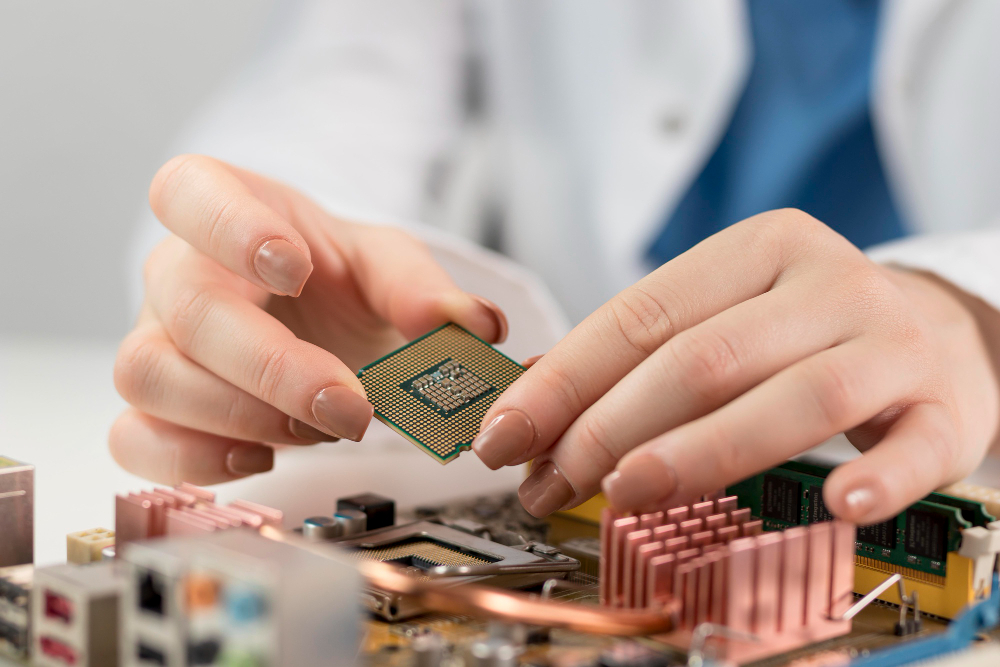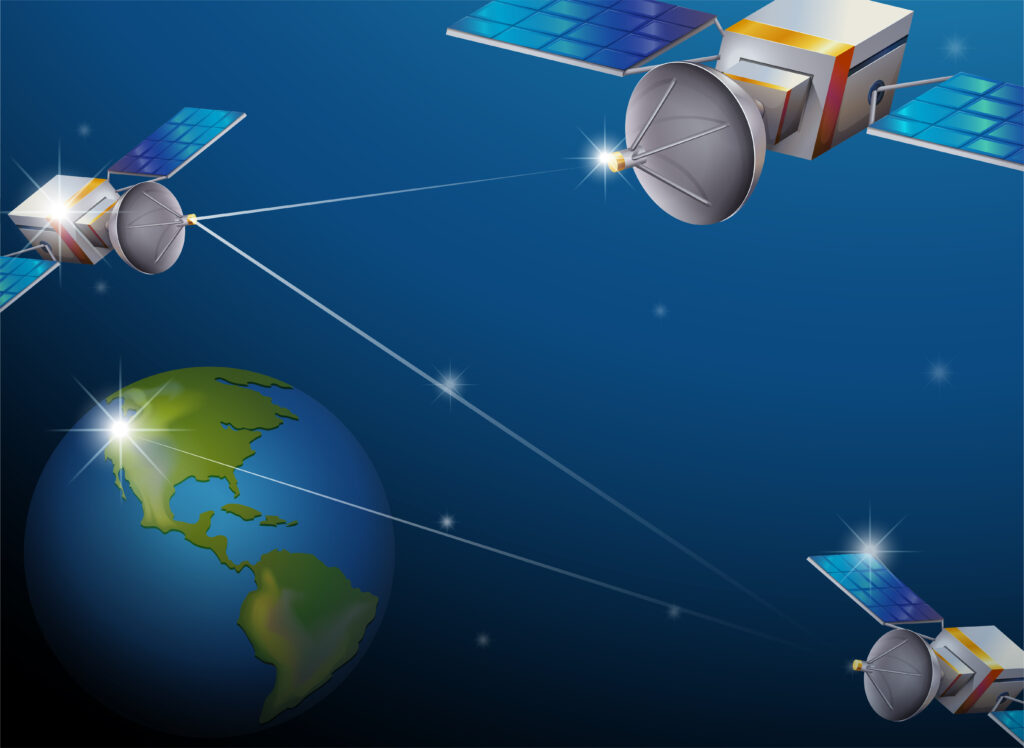The fast-paced evolution in satellite technology has transformed numerous domains, such as telecommunications, weather forecasting, defense, and scientific inquiry. The implementation of ASICs is one of the major causes of this development. Such specially designed chips have revolutionized the way satellites function, rendering them more reliable and efficient. ASICs enable the design of small-sized, power-efficient, and high-performance satellite systems by delivering hardware customized for a particular function. This has resulted in smaller yet more capable satellites that can easily perform advanced operations.
In this blog, we discuss how ASICs are shaping satellite technology’s progress, emphasizing their future benefits and possibilities. We also talk about how Nanogenius Technologies, an eminent ASIC design solution company, is making contributions to this space with an innovative semiconductor solution.
Overview of Satellite Technology
Satellite technology provides communication, navigation, weather monitoring, and scientific research. Satellites circle the Earth to carry data, monitor the environment, and assist in defense activities. Examples are communication, navigation (GPS), Earth observation (weather/climate), scientific (Hubble, Webb), and military satellites. Satellites consist of critical elements that facilitate their efficient performance. Solar panels supply energy, antennas allow for communication, propulsion systems regulate movement, onboard computers operate processes, and sensors obtain vital information.
Satellites have a vital impact of ASICs on worldwide connectivity, disaster recovery, and interstellar exploration. They affect day-to-day life by supplying GPS, internet connections, and meteorological forecasting, as well as facilitating scientific investigation and national security.
The Role of ASICs in Satellite Technology
- Power efficiency and performance optimization
Satellites are exposed to hostile environments with scarce power resources. ASICs are designed to utilize power effectively and just perform important work. As compared to general-purpose processors, which waste additional energy by processing numerous functions, ASICs accomplish limited operations with very little wasted power.
In the case of functions like image compression, encryption, and signal processing, ASICs exhibit high-speed execution at less power consumption. In such an effective way, satellites’ lives get prolonged, and the onboard system is made more reliable.
- Miniaturization and weight reduction
The main problem of designing satellites is how to maintain high performance but keep size and weight low. Common components such as FPGAs and general-purpose processors are multiple-chip packages that accomplish specific tasks and consequently add both power consumption and weight.
ASICs address this issue by combining several functions into one chip, shrinking the total size and weight of satellite electronics. Miniaturization is essential for today’s satellite constellations since smaller and lighter satellites lower costs and enhance deployment efficiency.

- Advanced signal processing and data management
Current satellites make use of sophisticated signal processing to converse with ground bases and other satellites. ASICs play a key role in accelerating such primary tasks as modulation, demodulation, error checking, and encryption.
They find particular applications in areas such as synthetic aperture radar (SAR), hyperspectral imaging, and GPS signal processing. Utilizing specialized hardware, ASICs make it possible to process data in real-time without relying much on software, which can be the source of delays and inefficiency.
The Evolution of Satellite Communication and ASIC Integration
- Evolution from Analog to Digital Systems
- There were analog-based satellite communications in early times, which experienced signal loss, interference, and sluggish data transfer.
- The introduction of these devices allowed for a straightforward shift to digital satellite communication equipped with enhanced signal quality, data rates, and improved security measures.
- ASICs allow quadrature amplitude modulation (QAM) and orthogonal frequency division multiplexing (OFM) to be implemented in satellites.
- These technologies have improved data capacity and spectrum efficiency, which have made satellite communication more reliable and accessible.
For further insights into the role of analog design in next-generation medical devices, check out this blog: The Impact of Analog Design on the Evolution of Next-Gen Medical Devices.
- Onboard data processing and high-speed data transmission
- The growing need for faster internet access, video streaming, and live satellite images has given onboard processing importance.
- ASICs enable satellites to perform data processing at high rates, enabling real-time image processing, onboard artificial intelligence, and sophisticated networking.
- ASIC-based processors support effective data compression in geostationary and low-earth orbit satellites.
- This allows large data volumes to be stored and sent without undue use of space, which is helpful to Earth observation satellites for real-time image transmission.
Benefits of Utilizing ASICs in Satellites
Miniaturization
- ASICs allow for small and light satellite systems.
- Necessary for space launches where weight is a major consideration.
- Permits greater space for other components or payloads.
Increased Integration
- Several functions integrated onto one chip.
- Decreases system complexity and increases efficiency.
- Permits simultaneous performance of tasks such as communication, navigation, and imaging.
Power Efficiency
- Uses less power than general-purpose ICs.
- Increases the operational life of satellites.
- Needed in satellites that are powered by sources such as batteries and solar panels.

ASICs and Radiation-Hardened Designs for Space Applications
ASICs for space applications have radiation-hardened (rad-hard) characteristics, allowing them to operate under extreme conditions with reliability. Rad-hard ASICs employ specific manufacturing processes, redundant designs, and Error-Correcting Codes (ECC) to reduce the impact of radiation.
Nanogenius Technologies, being a premier ASIC design house, offers radiation-hardened semiconductor solutions. With their expertise in creating robust ASICs for space missions, satellite systems are ensured to be functional even under extreme conditions.
Challenges and limitations of ASICs in satellite technology
High Development Cost
- Specialized skills and tools, as well as extensive processing and testing, are required when designing and manufacturing an ASIC.
- For smaller satellite companies and organizations that usually have tighter budgets, the costs can be quite daunting.
Limited Flexibility
- ASICs are not easily changed or upgraded once they are fabricated.
- System requirements changes or the addition of new features can necessitate a completely new ASIC design, which adds to development time and expense.
Not Suitable for All Applications
- Some satellite uses demand greater flexibility, which is available through general-purpose integrated circuits.
- Producers need to weigh the trade-offs and evaluate their needs very carefully before they select ASICs.
Further Reading: Explore The Ultimate ASIC Design and Development Service to understand how custom solutions address real-world challenges in product design.
The Future of ASICs in Satellite Technology
AI and Machine Learning Integration
AI and machine learning application in satellites is revolutionizing space technology. AI-tuned ASICs allow satellites to make autonomous decisions, recognize faults, and foresee future events in real time.
By processing the images onboard directly, the chips can recognize patterns and anomalies without sending huge amounts of data to earth stations. It minimizes latency and enhances efficiency.
For further insight into the influence of AI in ASIC design and on these semiconductor industries, see: How AI is Changing ASIC Design and the Semiconductor Industry.
Quantum cryptography and secure communication
With changing cyber threats, satellite communication security becomes important. Upcoming ASICs will incorporate post-quantum encryption algorithms and quantum cryptography for securing data communication between satellites and earth stations. This is particularly important for ultra-secure channels for military and government satellites.
Inter-Satellite Networking and Edge Computing
ASICs will facilitate inter-satellite networking and edge computing, which will see satellites exchange information directly and make decisions independently on data processing. This decentralized method increases efficiency, decreases latency, and facilitates real-time decision-making in satellite constellations.
Conclusion
ASICs have revolutionized satellite technology. The specialized chips have improved the efficiency and reliability of satellite imaging and communication. With ASICs, satellite systems can work more effectively, use less power, and run smoothly.
Certainly, ASICs do come with some issues, such as the high expense of development and low flexibility. Nevertheless, with the continuous advancements in chip design and production, these issues are being solved. As technology continues to advance, we can anticipate even more intelligent and stronger ASICs that will increase satellite performance and capabilities even more.
For more informative case studies and industry news, go to Nanogenius Technologies.

